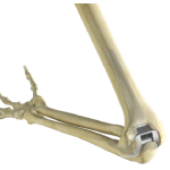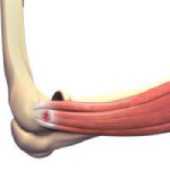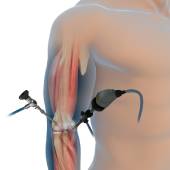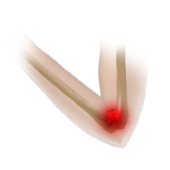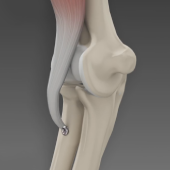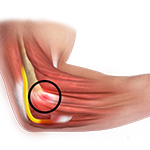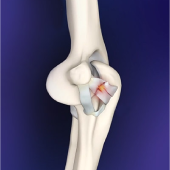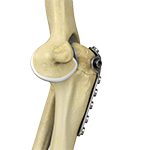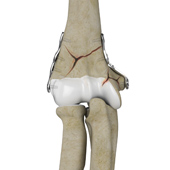Elbow Procedures
- Anatomy
- Conditions
- Procedures
Total Elbow Replacement
Elbow joint replacement, also referred to as total elbow arthroplasty, is an operative procedure to treat the symptoms of arthritis that have not responded to non-surgical treatments. The goal of elbow joint replacement surgery is to eliminate your pain and increase the mobility of your elbow joint.
Tennis Elbow Surgery
Tennis elbow is a common name for the elbow condition lateral epicondylitis. It is an overuse injury that causes inflammation and microtears of the tendons that attach to the lateral epicondyle.
Elbow Arthroscopy
Elbow arthroscopy, also referred to as keyhole or minimally invasive surgery, is a surgical procedure that is performed through tiny incisions to evaluate and treat several elbow conditions.
UCL Reconstruction
The ulnar collateral ligament (UCL), also called medial collateral ligament, is located on the inside of the elbow and connects the ulna bone to the humerus bone. It is one of the main stabilizing ligaments in the elbow, especially with overhead activities such as throwing and pitching.
ORIF of the Olecranon Fractures
Olecranon fractures are described as a break in the bony tip of the elbow that sticks out when you bend your arm. A fracture of the olecranon bone can be very painful and make motion of the elbow difficult or impossible. This kind of fracture is common and normally happens in isolation (with no other injuries involved).
ORIF of the Humerus Fractures
A humerus fracture is a condition that occurs when there is a break in the humerus or upper arm bone that commonly occurs as a result of severe trauma. Fracture of the humerus can affect the movement and function of your arm as well as your work and activities of daily living. Humerus fractures are quite common and occur in individuals of all ages from children to the elderly.
ORIF of the Coronoid Fractures
Coronoid fractures are a break in the coronoid process of the ulna due to trauma or injury. A coronoid fracture of the ulna is a complex intraarticular fracture that is difficult to expose due to complex surrounding anatomical structures. Fractures of the coronoid rarely occur in isolation and often occurs in association with elbow dislocations and play a significant role in elbow instability. Large coronoid fractures are often linked with persistent elbow instability even after reduction of the dislocation.
Distal Biceps Repair
The biceps is a large muscle located in the front of your upper arm and runs from the shoulder to the elbow joint. It is attached to the bones of the shoulder and elbow by tendons. The distal biceps is the area where the biceps is attached to the forearm bone in the elbow.
Distal biceps repair is a surgical procedure to restore a ruptured or torn distal biceps and tendon, caused by an injury.
Common Extensor Tendon Origin Repair
The common extensor tendon is a tough band of fibrous connective tissue that attaches to the lateral epicondyle of the humerus (long bone in the upper arm) at the elbow. Rupture or tear of the common extensor tendon is the most common acute tendon injury of the elbow. The most frequent pathology of the common extensor tendon is epicondylitis and is characterized by loss of normal tendon structure.
Elbow Ligament Reconstruction
Ligament reconstruction is considered in patients with ligament rupture. Your surgeon will make an incision over the elbow. Care is taken to move muscles, tendons, and nerves out of the way. The donor's tendon is harvested from either the forearm or below the knee. Your surgeon drills holes into the bones of the upper arm and forearm, around the elbow joint.
Elbow Tendon and Ligament Repair
The common conditions affecting the tendons around the elbow joint include tennis elbow and golfer’s elbow, which result from an overuse injury to the tendons in weight lifting, or from repetitive activities during sports or occupation.
Elbow Fracture Reconstruction
Elbow fracture reconstruction is a surgical procedure employed to repair and restore the appearance and full function of a damaged elbow caused by severe trauma or injury. This may include repairing damaged structures or replacing missing or damaged structures with adjoining skin, muscles, ligaments, tendons, bones, or nerves to restore the appearance and function. This may also include bone fusion (arthrodesis) or replacement of a joint (arthroplasty) to mitigate pain.
ORIF of the Distal Humerus Fractures
A distal humerus fracture is a condition that occurs when there is a break in the lower end of the humerus bone that commonly occurs as a result of severe trauma. Fracture of the distal humerus can affect the movement and function of your arm as well as your work and activities of daily living. Distal humerus fractures are quite common and occur in individuals of all ages from children to the elderly.


